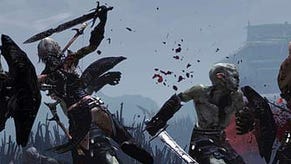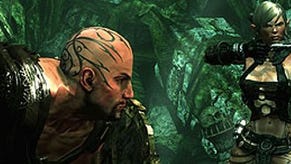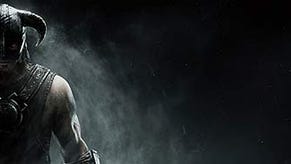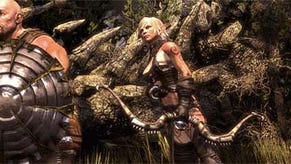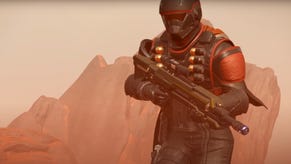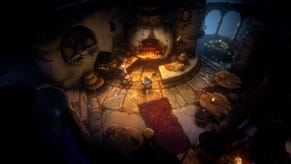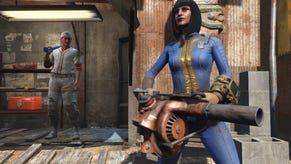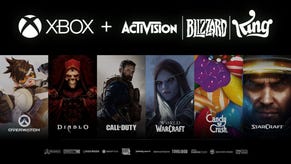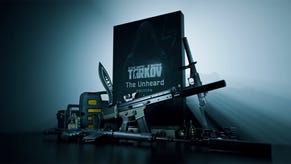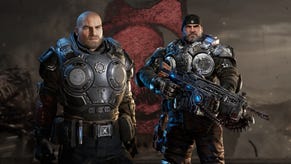inXile gives Hunted play-time, confirms map generator
Stace Harman takes another look at Hunted: The Demon's Forge before Bethesda's co-op fantasy Gears of War-alike releases on June 3. New shots included.
We begin at the beginning. After a sweeping cinematic that depicts a land in turmoil and leaves no doubt that armies of misshapen beasties to be slain, I’m thrust into the cramped solitude of a dark underground chamber, armed only with a torch. Hunted's opening, played out in thumping Dolby 5.1, has got me stirred up and ready to run riot, but first I must traverse a series of dark, cobwebbed corridors, following the voice of an unseen woman.
The corridors open out into a chamber and I’m confronted by a huge, horned demon erupting from the ground. It’s apparent from its size that it won't be taken down using just a torch and harsh language, and just as I’m readying myself to find out how fast I can run in the opposite direction, my character wakes up.
Caddoc, the burly, melee-centric human warrior, and E’lara, an Elven archer with a penchant for skimpy clothing and witty retorts, are camping in a forest. Some banter between the two quickly establishes the tone of the game to be "humourous," and then our extensive hands-on session begins proper, a single-player jaunt through the prologue which serves as a tutorial for inXile’s co-op focused action title that company president Matt Finley has jokingly referred to as ‘Gears of Warcraft’.
"This is absolutely a co-op game and has been the whole way along."
After the brief time spent running through dark corridors, the jungle setting of the prologue is rendered all the more attractive. I begin to suspect that inXile was deliberately playing on my expectations, which themselves were based on Hunted’s dungeon-crawler roots, in that I would be spending a lot of time underground. There’s no question that the Unreal Engine 3 has been put to stunning use here, and a waterfall vista halfway through the level is pretty enough to stand and admire.
You’ve got a friend in me
You have the choice to play as either Caddoc or E’lara from the start, and it’s apparent that both players are given equal billing; there’s no Resident Evil 5-style Sheva patsy, as Maxx Kaufman, Hunted’s game director, is keen to establish.
“This is absolutely a co-op game and has been the whole way along,” he insists.
“You can play through the campaign in single-player, and I think our AI partner is excellent, but our focus has been on the co-op elements the whole way through. This is reflected in the fact that even if you’re playing the single-player game, you’re levelling up the two characters throughout.”
Whichever character you initially choose, there are opportunities during levels to swap between the two so you can experience Caddoc’s up close and personal melee combat or E’lara’s more considered ranged abilities. Each also has a secondary weapon, which is weaker than the primary, but allows E’lara to quick-switch to a sword when the enemies close in and Caddoc to bring out a crossbow when time and distance allows.
Unsurprisingly, it’s teaming up with a buddy that shows the game’s strengths. Before we start our co-op experience, we’re introduced to the equipment upgrade options. A number of upgrade crystals are allocated for us to invest in our equipment and spells. Playing as E’lara, I imbue her bow with armour break and freeze abilities, as well as a fire-bomb spell that behaves like a grenade. My team mate, playing Caddoc, arms himself with a sword upgrade, a chain lightening spell and a levitation ability that lifts hapless enemies into the air to make easy fodder for my sharpshooting.
We play through level 1-4, in which we’re tasked with escaping a dungeon. Some light puzzle elements and an optional sub-objective of collecting runes to open an ominous looking crypt illustrate that you won’t always just be hitting things over the head. Breaking through to the outside world we must then reach a ballista to take out a huge tower that is raining fiery death upon us. It’s bloody, frantic and exhilarating.
On more than one occasion one of us is downed and we get to see the revival system in action: establishing a line of sight within the twenty or so seconds before bleed-out occurs allows a health vial to be lobbed to the prone player to revive themselves. It’s a smart mechanic in a game where, given the character’s relative strengths and weaknesses, you’re unlikely to be standing side-by-side for much of the time. It avoids tediously traipsing back and forth to revive your teammate.
Strategise this
Many of the abilities and spells are used to complement those held by your teammate, and as the game opens up, so too do further co-op strategies. The ability to ‘battle charge,' by charging certain spells for a few seconds before unleashing them on the other player rather than an enemy, effectively buffs your accomplice and enables them to deal and sustain more damage. Later in the game this ability can be upgraded further enabling ‘spell link’, essentially a battle charging of each other.
“It’s a screaming skull that tethers one player to the other; enemies that get caught up in the link between the two take massive damage,” Kaufman explains.
“But to do that you’re going to have to collect Dragon Tears to upgrade your battle charging ability."
It’s at this point that Kaufman explains how the upgrade system will work when playing on and offline.
“Let’s say you’re on chapter one and your buddy is on chapter two. You can set up a multiplayer session where you’re playing using his character set - your own character set or one character from each - in either of your games.
"The key thing here is, regardless of which set you use, you can choose to carry the upgrade crystals collected in that online game back to your own game, even if you’re on an earlier chapter.”
Kaufman goes on to explain how this affects the balance of the game.
The Crucible is described as a map generator.
“Now here’s the caveat to that: when you get deeper into the game and catch up to the chapter that you’ve done with your buddy, all of those crystals that you collected and chose to take back to your own game are no longer going to be available to collect again.
"Each upgrade crystal has its own unique ID, so once you’ve collected it, even in someone else’s game, it’s gone. So, although you might be levelling up your character earlier on, it actually has no significant longer term effect on the game.”
As you like it
Online multiplayer won’t be your only way of teaming up with a friend, as the team is pleased to announce that local split-screen co-op is also being included. Kaufman explains that it was something inXile considered early on, but didn’t want to promise in case performance or frame-rate issues caused a problem.
It seems inXile is not quite prepared to give up all of Hunted’s secrets just yet, though. The Crucible is described as a map generator, but nobody present will divulge further information other than to say that the gold you collect throughout the main game will be of use in this mode.
Whether that’s for wagering in some form of customised battle arena or used to purchase terrain and enemy types for custom built levels, we can only guess at this point.
More details are expected in a month or so and inXile’s president Matt Finley states that he’s expecting another round of hands-on time for this new mode, ahead of the game’s release on PC, 360 and PS3 on June 1 in the US and June 3 in Europe.




